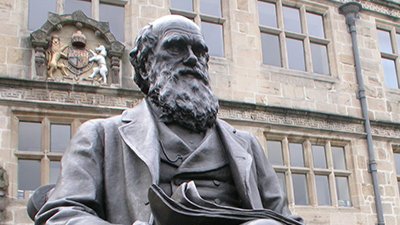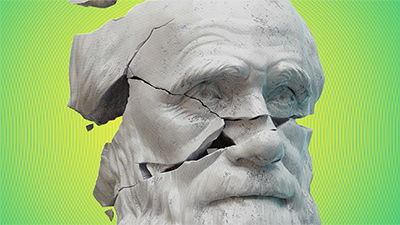
Darwin Still Debating the Creationists
Charles Darwin has been dead for more than 100 years, but devoted followers at the American Museum of Natural History have “resurrected” the man who popularized evolution so that he can take on the creationists once again.
An ambitious new exhibit opening this weekend at the American Museum of Natural History (AMNH) in New York City is the latest major effort by US evolutionists to promote their worldview. More than that, “Darwin”—which will travel to other major North American cities next year—will likely fuel America’s “culture wars” (the evolution/creation controversy being a growing part of the battle), not only because of the widespread media attention that this new exhibit is receiving but also because the museum’s guides are being trained to engage the creationist visitors who ask challenging questions.
According to the organizers, “Darwin” is the most comprehensive exhibit ever put on about the British naturalist. It begins with Darwin’s voyage on the H.M.S. Beagle, the ship that took him to the Galapagos Islands off the western coast of South America. In one of the displays, there is a diorama of animals that Darwin saw during his trip, with live Galapagos tortoises and other creatures being featured. The exhibit then leads visitors to a simulation of Down House, Darwin’s farmhouse outside London where he did much of his study and writing (including On the Origin of Species, the book which touched off the modern creation/evolution debate almost 150 years ago). And then a display deals with the tragic death of Darwin’s 10-year-old daughter, and explains how that devastating event prompted Darwin to abandon his religious faith (he wondered why a God would allow such a horrible thing to happen; by the way, for the answer to the often-asked question of why God allows suffering and death, read our popular online booklet Why Is There Death and Suffering?). He was an agnostic until he died.
After this history is presented in the exhibit, movies and other displays discuss how scientists, building upon Darwin’s observations of natural selection, supposedly use evolution as the basis for decoding the human genome and understanding things like the avian bird flu. (Incidentally, it was a creationist, Edward Blythe, who came up with the idea of natural selection. Today it is a concept that continues to be embraced by creationists; see Bearing Out Natural Selection—Creation Style.)
A correspondent with MSNBC calls the “Darwin” exhibit “perfect timing,” occurring “when the country is once again embroiled in a debate over evolution and its place in public education” in states like Kansas and Pennsylvania.1 In fact “Darwin” presents the concept of intelligent design as unscientific and as just another form of creationism (the two have significant differences, however—see ID and President Bush—the deeper issues).
In discussing how the museum staff at the AMNH are prepared to handle visitors who attempt to challenge the exhibit, Michael Novacek, the senior vice president at the museum, told MSNBC that “we suspect and certainly anticipate a variety of reactions.” He continued: “We’ve had that before, and we certainly welcome people to the show. … Our intention is not to try to convert or violate the beliefs of different people’s position.” Novacek added: “We might at least clarify some of their uncertainty with information and insight about a fascinating person and his great discovery.”2
Ellen Futter, the president of the museum, said that the $3 million exhibition was conceived three years ago and “is not a riposte [i.e., a type of thrust in the sport of fencing], but a celebration of Darwin’s life and his ideas, which are the cornerstone of modern biology.”3
A major goal of the exhibit is to take on the alternatives of Darwinian evolution.
The museum’s website, however, indicates that a major goal of the exhibit is to take on the alternatives of Darwinian evolution (i.e., creation and the intelligent design movement, also known as IDM): “The exhibition will address various controversies that have arisen surrounding the theory, since it was first put forward. The exhibition will also clarify the distinction between scientific theories and nonscientific explanations about the origin and diversity of life.”4
Paleontologist Dr. Niles Eldredge, a strong, long-time anti-creationist (author of The Triumph of Evolution … And The Failure of Creationism and The Monkey Business: A Scientist Looks at Creationism), is a curator of the exhibit. He has just written a book Darwin: Discovering the Tree of Life to coincide with his museum’s exhibit. So while the museum exhibit does not heavily deal with creation or intelligent design (there is an admission that the IDM is increasing), his companion book does. He attacks the proponents of “creationism” (he lumps the IDM in that broad category), with the book featuring chapter headings such as “Darwin as Anti-Christ: Creationism in the Twenty-First Century.” To his credit, Dr. Eldredge does not gloss over the negative effects that social Darwinism has wreaked on nations; for example, he mentions eugenics, which was a concept introduced by Darwin’s cousin, Francis Galton (the next issue of our Creation magazine, by the way, examines Galton’s life and the terrible consequences of his ideas).5
We asked Dr. David Menton, AiG speaker and writer (a Brown University graduate with a Ph.D. in cell biology) to comment on the claims by the president and senior vice president of the museum that the “Darwin” exhibit has some high education purpose and not a propagandistic one.
“I must say I find the claim very disingenuous that the $3 million exhibit on Darwinism is not intended as a ‘riposte’ against creation or the ID movement,” declared Dr. Menton.
This same museum spent a substantial sum of money to host their “Ancestors” exhibit in 1984. As explained in the first page of their book “Ancestors: The Hard Evidence” that came out in 1984, the main purpose of gathering together all the world’s hominid fossils—all that they could get, anyway—under one roof was a response to the “escalation of the creationist assault on evolutionary biology.”
Dr. Menton continued:
From page one of “Ancestors” we read:
We soon began to sense that the time was ripe: public as well as scientific interest was at a new high due to a spate of well-publicized discoveries and to the popular books derived from them, as well as because of the escalation of the creationist assault on evolutionary biology, a matter of great and growing concern at the Museum [emphasis ours].
On page two they become somewhat irrational with their comment about the supposed great risk of bringing all these rare hominid fossils together: “It cannot have been easy for them to justify the risks of transporting such delicate and irreplaceable specimens over vast distances, and of placing them on prolonged exhibit in the homeland of creationism [emphasis ours].”
Dr. Menton wonders if anyone truly believes that in 2005, with the creation/evolution controversy hotter than ever, that this museum can not be accused once again of engaging in a riposte against creationists. If evolutionists at the museum went to great lengths back in the 1980s to create “Ancestors” as a response to a “growing concern at the Museum” regarding “the creationist assault on evolutionary biology,” then they are even more determined to be anti-creationist today.
Even the world’s press has picked up on the anti-creation/anti-ID agenda at the museum. A headline in a South African-based website declared: “Darwin exhibit challenges creationists,”6 (similar headlines have appeared elsewhere in the international press). In the USA, the New York Daily News reported that a fundraiser last Wednesday evening for the museum “evolve[d] into something of a rally against President Bush’s preferred theory of intelligent design.” At that event, former NBC-TV newsman Tom Brokaw, a museum supporter, was quoted by the paper as stating that “this is a time when those of us who care about science and Darwin have to take a stand.” More and more, the anti-creation, anti-ID biases of those associated with the museum are being revealed.7
The exhibit will be open until May 29. Then it is scheduled to travel to Boston, Chicago and Toronto. Eventually it heads off to London, England.
Such concerted efforts by secular science museums to increase their evolutionary content (including the upcoming “Evolving Planet” exhibit at the famous Field Museum in Chicago, Illinois, USA … see Museums take up evolution challenge) should concern Christians to think about supporting Bible-proclaiming institutions such as the ICR Museum of Creation and Earth History near San Diego, California, as well as to help ensure that, with their generosity, they can see AiG’s Creation Museum open in the spring of 2007 in the Cincinnati, Ohio area. The Creation Museum will be a welcome antidote to the natural history museums around America that are increasingly presenting an evolutionary, anti-Christian viewpoint.
Footnotes
- www.msnbc.msn.com/id/10007371
- Ibid.
- “An Evolutionist’s Evolution,” The New York Times, www.nytimes.com/2005/11/07/nyregion/07darwin.html, November 7, 2005.
- www.amnh.org/exhibitions/darwin/?src=h_h
- It is ironic that Dr. Eldredge is not a proponent of Darwin’s view that evolution has occurred gradually. Instead, Eldredge is a cofounder of the evolutionary concept of “punctuated equilibria” (PE grew out of a recognition by him of “stasis”—lack of gradual change—in the fossil record).
- cooltech.iafrica.com/science/565404.htm; iafrica.com describes itself as “Africa’s most magnetic Internet destination by delivering internet users with only what they want.”
- www.nydailynews.com/front/story/366907p-312314c.html
Recommended Resources

Answers in Genesis is an apologetics ministry, dedicated to helping Christians defend their faith and proclaim the good news of Jesus Christ.
- Customer Service 800.778.3390
- © 2024 Answers in Genesis






